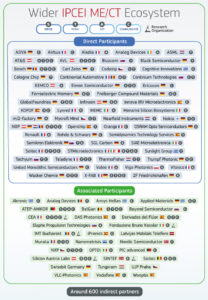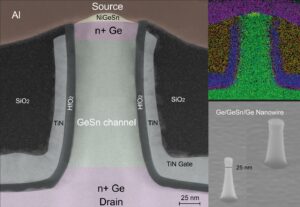
EDACafe Editorial Roberto Frazzoli
Roberto Frazzoli is a contributing editor to EDACafe. His interests as a technology journalist focus on the semiconductor ecosystem in all its aspects. Roberto started covering electronics in 1987. His weekly contribution to EDACafe started in early 2019. More semi subsidies; Intel’s BPD advancements; qualities of GeSn alloy; EV charging defacto standardJune 12th, 2023 by Roberto Frazzoli
Updates concerning automotive applications make up a significant part of this week’s news roundup. Among the other themes, backside power delivery is getting closer to real-life applications; and more subsidies are going to benefit the European semiconductor ecosystem. More European subsidies In addition to the EU Chips Act, the European Union and some individual member States are going to provide more subsidies to their domestic semiconductor ecosystem. The European Commission has approved an “Important Project of Common European Interest” (‘IPCEI’) to support research, innovation and the first industrial deployment of microelectronics and communication technologies across the value chain. Fourteen member States will provide up to €8.1 billion in public funding, which is expected to unlock additional €13.7 billion in private investments. As part of this IPCEI, 56 companies, including small and medium-sized enterprises and start-ups, will undertake 68 projects. Separately, the French government has announced it will provide 2.9 billion euros ($3.10 billion) in state aid to help support an investment of 7.5 billion euros that STMicroelectronics and GlobalFoundries are making to build a semiconductor factory in Crolles, France.
Intel advancements on backside power delivery Intel has succeeded in implementing backside power delivery on a “product-like” test chip. Called PowerVia – Intel’s version of the BPD solution, that consists in moving power routing to the backside of a wafer – the new technology will be introduced on the Intel 20A process node in the first half of 2024. Intel decoupled development of PowerVia from RibbonFET transistor development to ensure its readiness for silicon implementation based on Intel 20A and Intel 18A process nodes. To this goal, the company devised mitigation techniques to prevent the thermals from becoming an issue, and new test techniques for debugging. As a result, the test implementation delivered solid yield and reliability metrics while demonstrating the intrinsic value proposition of the technology well before it joins new RibbonFET architecture. Intel claims that PowerVia is well ahead of competitors’ backside power solutions. The company will present these achievements in two papers at the VLSI Symposium on June 11-16 in Kyoto, Japan. In a third paper, Intel will explain more advanced methods to deploy PowerVia, such as enabling both signaling and power delivery on either the front or the back side of the wafer. Germanium-tin alloy a candidate for future transistors Scientists from French research institute CEA-Leti have demonstrated that electrons and other charge carriers can move faster in a germanium-tin alloy than in silicon or germanium, enabling lower operation voltages and smaller footprints. This proof-of-concept breakthrough means vertical transistors with a channel made of germanium-tin alloy are promising candidates for future low-power, high-performance chips and possibly quantum computers. Germanium-tin alloy is compatible with the existing CMOS process for chip fabrication, and offers a tunable energy bandgap by varying the percentage of tin content. New semiconductor startups Silicon Catalyst, a startup incubator focused exclusively on accelerating semiconductor solutions, has announced the admission of four new companies into its program. The newly admitted companies are: Cambridge Terahertz (whose mission is “Democratizing the Terahertz spectrum through CMOS phased array technology”), Liitto (“Computing Solutions for the Clean Energy Era”), Veevx (“Intelligent Memory Chiplets”), and weeteq (“The “tiny” embedded technology company”). Renesas contributing to simplification of EV architecture Japan-headquartered Nidec Corporation and Renesas have agreed to join forces on the development of semiconductor solutions for next-generation “e-axles”, key components of electric vehicles. Current e-axles integrate three elements: an electric motor, its power electronics (inverter) and a gearbox. One of the next generation e-axles being developed by Nidec and Renesas will integrate six elements: in addition to motor, inverter, and gearbox, it will also include a DC-DC converter, on-board charger, and power distribution unit. Another e-axle project will incorporate a battery management system and other components. Power electronics will include devices based on silicon carbide and gallium nitride. Towards a US defacto standard for EV charging: Ford-Tesla and GM-Tesla agreements Both Ford and General Motors have recently signed agreements with Tesla providing their respective electric vehicles customers access to more than 12,000 Tesla Superchargers across North America. Both Ford and General Motors have also announced that from 2025 their respective electric vehicles will be equipped with the North American Charging Standard (NACS) connector. Prior to 2025, connecting a Ford or GM EV to a Tesla Supercharger will require the use of an adapter. According to GM’s CEO Mary Barra, this collaboration “could help move the industry toward a single North American charging standard.” Marvell’s new automotive Ethernet switches Marvell has announced the Brightlane Q622x family of high-capacity central Automotive Ethernet switches. One of the members of the family, the Brightlane Q6223 switch, delivers 90 Gbps of bandwidth, nearly twice the capacity of currently available automotive switches, with a non-blocking 12-port design that can be configured in different ways. The new switch family also includes a combination of advanced security features including the encryption of data traveling between automotive components and deep packet inspection. Arm-based Dual Core R52 processor provides higher performance and lockstep redundancy. Smartphone downturn in 1Q23 According to market research firm TrendForce, the global production volume of smartphones in 1Q23 was only 250 million units, marking a 19.5% year-on-year decrease. This represents not only the greatest annual decrease but also a historic low in quarterly production since 2014. TrendForce explains these figures citing the ongoing global economic downturn, that continues to impact consumer confidence. Acquisitions Renesas has acquired Austria-headquartered Panthronics, a fabless semiconductor company specializing in Near-Field Communication (NFC) technology. The company has also announced thirteen reference designs combining Renesas and Panthronics products, for a range of applications that can take advantage of NFC. Apple has reportedly acquired Mira, a Los Angeles-based augmented reality startup that makes headsets for other companies and the US military. Further reading German think tank “Stiftung Neue Verantwortung” has analyzed 17,518 invited papers to the three leading semiconductor conferences (IEDM, ISSCC, and VLSI Technology and Circuits) over the last 28 years, as a proxy for semiconductor “research power”. The analysis has provided several interesting findings; among them, academia took over, compared to industry; and international collaboration seems to have plateaued. |
|
|
|||||
|
|
|||||
|
|||||








